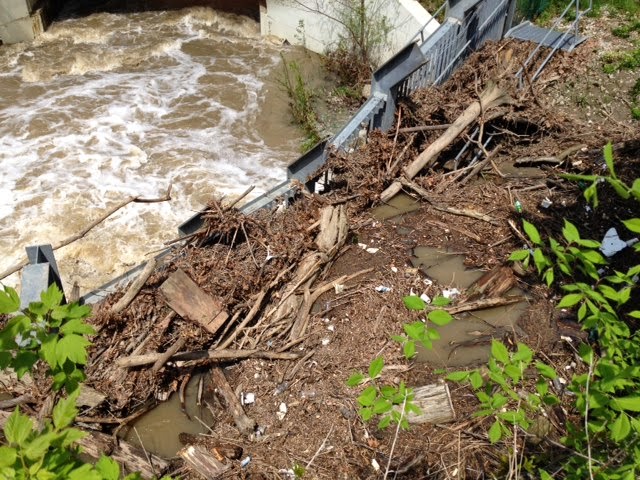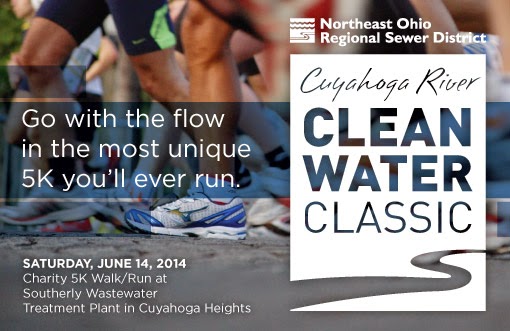
NEWS: Litigation hinders ability to assist communities hit by Monday’s storm [#StormwaterProgram]
Posted by Jared Shepherd
- 4118 Views
- May 13th, 2014
- in Miscellaneous
- No Comments
 |
| A stream rack holds back storm debris near Cleveland Hopkins International Airport following a heavy rain event May 12. |
$20 million remains inaccessible in stormwater escrow
Northeast Ohio communities are underwater from the storm that moved into the region on Monday night. Unfortunately, as a result of the Ohio Eighth District Court of Appeals ruling that the Northeast Ohio Regional Sewer District does not have the authority to implement a Regional Stormwater Management Program, affected communities are now left to address the aftermath without the Sewer District’s assistance and expertise.
Ironically, the storm occurred on the same day those in support of the Regional Stormwater Program filed amicus briefs with the Ohio Supreme Court on the Sewer District’s behalf. They include 18 supporting member communities (one brief), City of Cleveland, National Association of Clean Water Agencies and Association of Ohio Municipal Wastewater Agencies, Coalition of Ohio Regional Districts, The State of Ohio through the Ohio Attorney General’s Office, and The Cleveland Metroparks.
“This is a very unfortunate situation. The Sewer District has an established Regional Stormwater Management Program designed to proactively address stormwater problems, and rapidly respond after a storm hits,” stated Frank Greenland, Director of Watershed Programs. “We have the personnel and $20 million dollars in a stormwater escrow account to help but, legally, our hands are tied. It’s very frustrating, particularly since more rain is predicted over the next several days.”
Reports of flooding and damage have been reported, including in:
- Brecksville: Flooding at multiple locations along Vaughn Road by the Cuyahoga River.
- Olmsted Falls: Flooding at Bagley Road by Plum Creek.
- Olmsted Township: Flooding throughout Plum Creek watershed with road flooding at Sprague Road.
- Sagamore Hills Township/Valley View Municipal Boundary: Flooding of Sagamore Creek with road flooding at Canal Road.
- Seven Hills: Activating of the emergency spillway on Hemlock Creek Forest Overlook Basin during and debris build up on the spillway.
- Strongsville: Flooding of Drake Road and area basements by Baker Creek.
- Strongsville: Flooding of State Route 82 and structural damage to the road from the East Branch of Rocky River.
- Independence: Flooding of Fitzwater Road by the Cuyahoga River.
Note: This is not an exhaustive list.
“The Sewer District would have cleared blocked culverts, removed debris from local streams, and helped communities minimize damage from this storm,” stated Greenland. “For example, last year, under the Regional Stormwater Management Program, the Sewer District was able to rapidly assist Pepper Pike in its clean-up effort after a tornado ripped through the community. We can do none of this now.”
In addition to the funding and expertise the Sewer District could have provided, the Regional Stormwater Management Program includes additional funding for local projects. It provides funding to the member communities within the Sewer District’s service area for community-specific stormwater management projects. Each community would receive 25% of the total annual stormwater fee revenue collected (in its community). For example, the City of Strongsville would have approximately $322,000 annually available under this local fund to use for projects such as clearing local storm sewers and addressing resident concerns.
“It is clear a majority of the Sewer District’s member communities and others understand the significant benefit of the program,” stated Julius Ciaccia, Sewer District Executive Director. “By continuing to prevent the Sewer District from proactively addressing long-standing stormwater issues and rapidly responding to requests for assistance, communities will continue to see increasing problems, like those experienced on Monday evening, and the cost to address those problems will only escalate.”
Communities in opposition of the Sewer District’s Stormwater Management Program include: Beachwood, Bedford Heights, Cleveland Heights, Glenwillow, Independence, Lyndhurst, Oakwood, Strongsville and Brecksville. The Northeast Ohio Apartment Association, et al, is an opposition party, as well.
Stormwater Program Court Case Timeline:
- January 7, 2010: The Sewer District filed the initial complaint for declaratory judgment, the same day the Sewer District’s Board of Trustees unanimously voted to adopt Title V, the section of the Sewer District’s Code of Regulations that details the Regional Stormwater Management Program. This court action asked the court to reaffirm the Sewer District’s authority to establish a stormwater utility.
- April 21, 2011: Cuyahoga County Court of Common Pleas Judge Thomas J. Pokorny issued his first opinion in the case of Northeast Ohio Regional Sewer District vs. Bath Township, Ohio, et al. (CV-10-714945). In this decision, Judge Pokorny ruled that Chapter 6119 of the Ohio Revised Code gave the Sewer District the authority to implement most of the Regional Stormwater Management Program. He also ruled that consent of member communities to participate in the program is not required.
- February 15, 2012: Judge Pokorny issued his second opinion in the case. In this ruling, he ruled that the Sewer District’s Stormwater Management Program fee is authorized under Chapter 6119 of the Ohio Revised Code; the charges proposed are ruled a fee, and not a tax as the Defendants argued.
- June 28, 2012: Judge Pokorny issued his third and final opinion in the case. This final ruling acknowledged several recommended program changes the Sewer District made – most notably an increase to the Community Cost-Share Program to benefit member communities – by recommendation of the Judge.
- September 26, 2013: The Ohio Eighth District Court of Appeals ruled against the Sewer District in finding that the agency does not have the authority under Ohio Revised Code Chapter 6119 – or its charter – to implement the Regional Stormwater Management Program under Title V or collect the associated stormwater fee.
- November 12, 2013: The Sewer District asked the Ohio Supreme Court to hear the case. The Eighth District Court of Appeals’ prior ruling jeopardizes stormwater programs throughout the State of Ohio.
- February 19, 2014: Ohio Supreme Court agrees to hear the case.
Customers with questions about their accounts can contact the Sewer District’s Customer Service Department at 216.881.8247 or email Sewer District representatives at askus@neorsd.org.
About the Program:
The Sewer District’s Regional Stormwater Management Program will address flooding, erosion and water quality problems throughout its defined service area. In addition, the Sewer District will assume responsibility for millions of dollars of necessary maintenance along streams across the region.
The average homeowner within the Sewer District’s Stormwater Service Area was charged $5.05 per month, or $60.60 per year, to pay for stormwater-related construction projects and maintenance. The Sewer District identified more than $220 million of needed construction projects, and detailed planning on some projects has already begun. These stormwater-related projects will provide relief to multiple communities within each watershed. Several emergency projects were completed in 2013 and others were actively under construction. Projects with alternative funding sources are continuing until funds are exhausted, whereas other much-needed projects were immediately suspended.
Other Stormwater Impacts:
- Combined sewer overflows: As a result of heavy storms on Monday, the Sewer District did experience combined sewer overflows, a mixture of sanitary and stormwater, discharging into the environment. Project Clean Lake, the Sewer District’s $3 billion plan, will reduce discharges from 4.5 billion to 500 million by 2035.
- Treatment plant capacity: Also, the Sewer District’s collection system experienced an increase in flow. For example, the Southerly Wastewater Treatment Plant treated a peak flow of more than 700 MGD. Typically, its average daily flow is 125 MGD.


